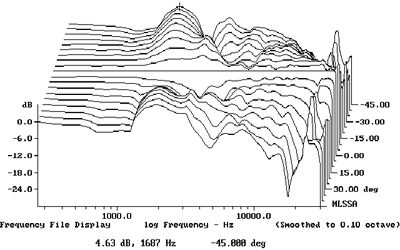| Columns Retired Columns & Blogs |
Acarian Aln Petite loudspeaker & PW-1 woofer system Measurements
Sidebar 3: Measurements
As expected from its diminutive proportions, the Petite is not very sensitive, 2.83V raising a calculated 83dB at 1m (B-weighted). However, its impedance traces (fig.1) reveal it as an easy load for an amplifier to drive, dropping below 8 ohms only in the midrange. Though no wrinkles can be seen in the impedance traces, the cabinet was generally lively in the 350-500Hz region. No strong individual resonant modes could be found, however, which suggests an optimally constructed cabinet.

Fig.1 Alón Petite, electrical impedance (solid) and phase (dashed) (2 ohms/vertical div.).
Fig.2 shows the individual responses of the Acarian's drive-units on the tweeter axis at a measuring distance of 50". (The lower reaches of the woofer's output and the port response were measured in the nearfield.) The crossover can be seen to lie around the specified 3.5kHz, though the woofer has a distinct step in its output just above 1kHz. The output of the tiny port is the bandpass centered on the woofer's minimum-motion frequency, 52Hz, and I noticed considerable chuffing and wind noise coming from it at even moderate levels when the speaker was driven by a pure sinewave. Luckily, music will offer some masking and the port does face the rear.

Fig.2 Alón Petite, acoustic crossover on tweeter axis at 50", corrected for microphone response, with nearfield woofer and port responses plotted below 300Hz and 1kHz, respectively.
How these individual responses sum on the tweeter axis can be seen in fig.3. The complex sum—magnitude, phase, and distance—of the woofer and port low-frequency outputs rolls off gently below 100Hz, reaching the 6dB-down point at a moderate 55Hz; not bad extension for such a small speaker. Though the overall balance is smooth and even, the step in the woofer's on-axis response remains a distinct feature.

Fig.3 Alón Petite, anechoic response on tweeter axis at 50", averaged across 30 degrees horizontal window and corrected for microphone response, with complex sum of nearfield woofer and port responses plotted below 300Hz.
This response shape is almost always associated with a pronounced nasality to a speaker's sound, in my experience, so I was initially puzzled as to why WP didn't notice any excessive coloration. Then I read that he had to tilt the speaker backward quite a ways to get a balance he liked. My choice of the tweeter axis was not optimal, therefore. Fig.4 shows how the Petite's response changes as the listener moves up or down from the tweeter axis. (Just the response differences are shown in this graph; hence, the tweeter-axis response appears to be a straight line.) As can be seen from fig.4, the speaker's output in the region just above the step increases by up to 5dB for listening angles more than 15 degrees above or below the tweeter axis. The response on WP's preferred axis is shown in fig.5—though a slight discontinuity can be still be seen at 1kHz, the response is pretty flat overall.

Fig.4 Alón Petite, vertical response family at 50", normalized to response on tweeter axis, from back to front: differences in response 45 degrees-5 degrees above tweeter axis; reference response; differences in response 5 degrees-45 degrees below tweeter axis.

Fig.5 Alón Petite, anechoic response on optimal axis at 50", corrected for microphone response, with complex sum of nearfield woofer and port responses plotted below 300Hz.
- Log in or register to post comments




































